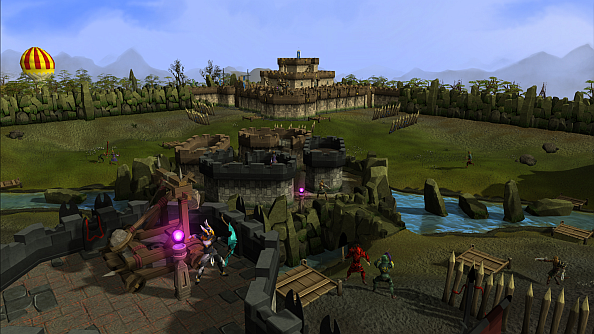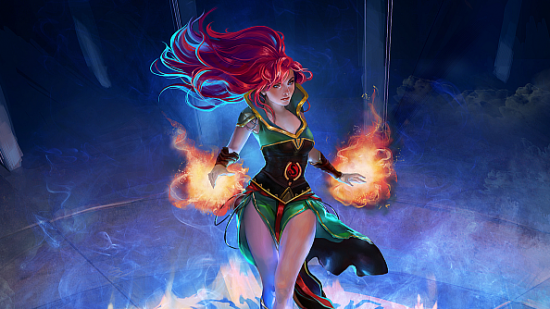It’s been seven long years since I played Runescape. It was my first MMO. Back then, Runescape was magical. It marked the beginning of my, and many other’s, fascination with huge worlds populated by real people. But I left Gielinor behind: moved on to new games and new places.
Today, Jagex want me, and the millions of the other players that fell for the original Runescape back. They have a new plan, a new way of breathing life into Gielinor. They want to create a living world, content updates created from player demands, a game built to play across computers and tablets via HTML5, and an overhauled UI.
It’s the most ambitious project in Jagex’s history.
The question is: is it enough?
Runescape is big. According to Jagex In the twelve years since launch, 200 million accounts have been created, resulting in a 450 billion minutes of play time. These impressive figures are overshadowed by one important fact: Runescape is still growing.
Last year Runescape saw such explosive growth that Jagex decided to double the size of their development team, and begin work on their third evolution of their iconic MMO: Runescape 3.
The first question the team had to answer was technological. “Java really isn’t in a great state anymore” said executive producer Phil Mansell. “Java has a real ceiling over what it can provide architecturally, but we’re still grateful for what it has been able to provide us and our players until now”. Instead, the team have embraced HTML 5.

That’s led to a significantly prettier game: the draw distance is now far into the horizon – removing the thick grey fog that plagued the previous game. Shadows have also been improved, with the now visible sun projecting a soft shade of my character on the floor.
Most noticeable is the sky: it sounds like a small thing but since launch, Runescape has been without a skybox. Now, the camera can now move in a true 360 degrees.
There’s a new interface, too. It feels familiar to old players, but includes what Jagex call “a tear and share system.” It’s also closer to the standard you’d expect from other MMOs: you can alter the UI’s size and colour, or mimic the current UI or legacy UI to ease your transition. UI changes are saved to your account, following you wherever you log in.
HTML 5 is cross platform: it delivers the same experience in a browser across multiple machines. That means Runescape can and will appear on other platforms, including tablets.
“We’re pleased to announce that Runescape 3 will be coming to tablets and other devices by the end of the year” announced lead content designer Mark Ogilvie, otherwise known as Mod Mark. “With HTML5 we can deliver our game to even more of our community whether they’re on the PC or on the move”.
But how does it play?
Like an old friend. Within a few moments of logging in, I was running around town, feeling a wave of nostalgia. On a pre-made account, I stumbled into a bank. In the vault, I found a Ring of Kinship, and equipped it immediately. It had an activate option. I clicked, and was immediately engulfed in a wave of light.
I reappeared in the Wilderness.

This is when the nostalgia really hit me. The Wilderness was the home to my greatest triumphs seven years ago. It’s a place where player combat is condoned. It’s about risk and reward: die here and you lose nearly all your inventory and equipment. But the Wilderness is home to the shiniest loot, and the most powerful of monsters.
Today, I felt safe. I was clad in super high level armour, and I was fairly certain no other journalist was here. It felt like a perfect opportunity to test out Runescape’s new combat.
I found an imp that needed beating up. You can start fighting by either clicking on your target or using a contextual menu. When you enter combat, you switch between hitting in melee and firing at range, depending on the type of weapon equipped. Something that’s new to me is the new adrenaline system. It’s already in the current game, but’s been refined. By using skills you can increase your adrenaline bar, which can be spent on powerful combos and finishers.

Skills have always been a foundation of Runescape, determining your effectiveness, level and utility. The community have always wanted new ways to increase these skills, as they slowly become another staple grind. Dungeoneering is one of the solutions: a repeatable, random and dynamic dungeon which helps you increase your combat skills alongside the aptly named “Dungeoneering” skill.
The build that I played featured over fifty floors. Each includes randomly generated rooms and monsters. Upon entering you are presented with an armoury that’s filled with equipment. You can then choose a direction to head in, with each door opened building a room and foes on the spot. Some rooms will require you to find keys to advance, others ask you to kill every enemy in sight. At the end of each floor, players face a boss before they can advance to the next floor. Slaying bosses reward players with XP and items, according to a bonus score system. Killing every enemies, taking no damage and finding all the secrets in a floor will multiply your score. It’s a clever, fun addition; a time sink that every MMO should consider.
It’s not the only innovation. Jagex are exploring the idea of allowing players to determine the story of their episodic content. They’ll write multiple choices and outcomes and change them according to the actions of players. This includes fully voiced cutscenes and dialogue.
“We want to put the power in the players hands with Runescape 3” says Mod Dean. “What we’re really trying to get across is that we’re redefining the relationship between the players and the game, something that hasn’t been done until now.”
It’s a tough ask, but Jagex have form. Runescape is already updated every week, and their quests and writing is better than you might expect.

Here’s an example: one quest I tried is called “Let them eat pie”. The setup was odd: a local merchant named Rolo had been buying up all the food and reselling it at a vast markup. If I could make him ill, I could sneak into his house, steal his seal, and fake a letter that would release his stock to the locals. The answer: I needed to bake a poisonous pie.
It sounds simple, but I had to make a maggot infested baked good appear and taste appetising. Many of Runescape’s quests involve using non-combat skills. Here, I used cooking to combine a muddy fish, an old potato and maggot filled wheat. Spicing it made it edible. Rolo’s accomplice had some, but wasn’t willing to part with it. I had to take it by other means: pickpocketing.
With the pie ready, I walked into the tavern where he was usually found. Rolo was easy to spot, he was exceptionally obese. What happened next was horrific: Jagex’s sound developers clearly enjoyed creating the vomit effects. And more.

Runescape’s PvP includes a new mode: Castle Wars. It’s capture the flag, set between castles, and includes siege weapons and barricades. There isn’t any limit to the team sizes, as long as they’re balanced. As a returning player I was able to score a few kills and points here and there, but fast paced action was a little clunky. I’m putting that down to my own inexperience: JMODs (community moderators) didn’t appear to have any problems playing.
Runescape 3 should be welcomed with open arms by the existing community. The HTML 5 shift by itself would be huge news: bringing Runescape to tablets and more is a spectacular feat of engineering.
For new or lapsed players, though, it’s a harder sell. Runescape is a better game than you might give it credit for: its strength is in it’s accessibility and a wealth of content.
And it’s free. You should probably try it when Runescape 3 launches this summer.
